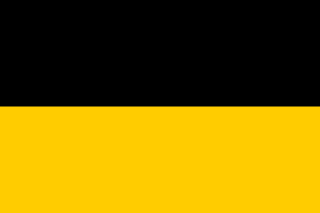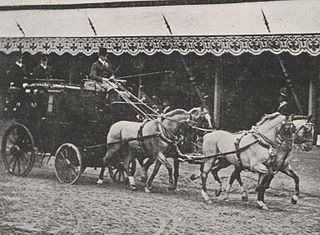
At the 1900 Summer Olympics, three croquet events were contested. Seven men and three women participated. The doubles competition was scheduled first, though it is unclear whether the French pair that won had any competition. The one-ball singles was played the next week, followed by two-ball singles the week after. France, which supplied all 10 competitors, therefore won all the medals.
Five equestrian competitions were held from 29 May to 2 June 1900 at the Concours Hippique International in Paris as part of the Exposition Universelle. The events were later classified as part of the 1900 Summer Olympics. The events were organised by the Société hippique française, with competitors from eight countries competing in three jumping and two driving events at the Place de Breteuil in the 7th arrondissement of Paris.

At the 1900 Summer Olympics one gymnastics event for men was contested. The competition was held on Sunday, 29 July 1900, and on Monday, 30 July 1900. There were 135 competitors from 8 nations. The top 18 places were taken by French gymnasts, of which there were more than 100. The event was won by Gustave Sandras, with Noël Bas finishing second and Lucien Démanet third. The highest-placing foreign gymnast was Jules Ducret of Switzerland, in a tie for 19th place.

At the 1900 Summer Olympics in Paris, many shooting events were featured within the concurrent 1900 Exposition Universelle, but only eight events currently are considered as "Olympic" by IOC. Before July 2021 the International Olympic Committee has never decided which events were "Olympic" and which were not. The competitions were held from 3 August to 5 August and took place at the military sporting complex in Satory and at Boulogne-Billancourt. According to Olympic historian Bill Mallon, one of these nine shooting events was an event for professionals with prize money and therefore does not meet inclusion criteria for 1900 Olympic Games events.

At the 1900 Summer Olympics in Paris, seven swimming events were contested. Only men competed in the swimming competition. There was a total of 76 participants from 12 countries competing. As with the rowing events, swimming took place on the Seine between the Courbevoie Bridge and the Asnières Bridge.

Belgium competed at the 1900 Summer Olympics in Paris, France. It was the first appearance of the European nation. Belgium was represented in France by 78 athletes, all of them male, who competed in 11 disciplines. They comprised 95 entries in 28 events.

Austria competed at the 1900 Summer Olympics in Paris, France. Austrian and Hungarian results at early Olympics are generally kept separate despite the union of the two nations as Austria-Hungary at the time.

The Russian Empire competed at the 1900 Summer Olympics in Paris. It was the first appearance of the European nation, which had entered the names of competitors for the first modern Olympics in 1896 but had failed to appear.

Argentina competed at the 1900 Summer Olympics in Paris, France, the nation's debut appearance out of two editions of the Summer Olympic Games. Argentina did not participate in the inaugural 1896 Summer Olympics. Francisco Camet has the distinction of being Argentina's debut Olympian in the nation's debut Olympic sporting event, men's épée, placing fifth overall.

Obstacle jumping was one of five equestrian competitions held in late May and early June 1900 at the International Horse Show in Paris. The event was part of the Exposition Universelle, and later classified as part of the 1900 Summer Olympics. It was similar to the modern show jumping event. 45 competitors entered, though only 37 competed, with some information unknown. The event was won by Aimé Haegeman of Belgium, with his countryman Georges Van Der Poele taking second and Louis de Champsavin of France in third.

The high jump was one of five equestrian competitions held in late May and early June 1900 at the International Horse Show in Paris. The event was part of the Exposition Universelle, and later classified as part of the 1900 Summer Olympics. It is the only Olympic Games to date to feature an equestrian high jump competition. Nineteen competitors entered the high jump competition, although not all details have been discovered.

The long jump was one of five equestrian competitions held in late May and early June 1900 at the International Horse Show in Paris. The event was part of the Exposition Universelle, and later classified as part of the 1900 Summer Olympics. It is the only Olympic Games to feature an equestrian long jump competition. Of the seventeen competitors who entered, around half are known by name. The event was won by Constant van Langhendonck of Belgium, with Gian Giorgio Trissino of Italy in second and Jacques de Prunelé of France in third.

The four-in-hand mail coach driving was one of five equestrian competitions held in late May and early June 1900 at the International Horse Show in Paris. The event was part of the Exposition Universelle, and later classified as part of the 1900 Summer Olympics. There were 31 entrants listed for the event; all 28 of them are known by name. The event was won by the team of Georges Nagelmackers of Belgium. The teams of Léon Thome and Jean de Neuflize, both of France, were classified in second and third place respectively.
Henry Berry Slack was an American track and field athlete who competed at the 1900 Summer Olympics in Paris, France.
Georges Claude Clément was a French track and field athlete who competed at the 1900 Summer Olympics in Paris, France.
Karel Nedvěd was a Bohemian track and field athlete who competed at the 1900 Summer Olympics in Paris, France.
Eugène Marc Antoine Besse was a French track and field athlete who competed at the 1900 Summer Olympics in Paris, France. Besse competed in the marathon. He placed fourth with a time of 4:00:43 over the 40.26 kilometre course.
Léon Monnier was a French track and field athlete who competed at the 1900 Summer Olympics in Paris, France. Monnier competed in the high jump, finishing seventh of eight with a best jump of 1.60 metres.
Maurice Durquetty was a French pelotari who competed at the 1900 Summer Olympics in Paris, France.

The men's 300 metre free rifle prone event was one of five free rifle events of the competitions in the Shooting at the 1900 Summer Olympics events in Paris. It was held from August 3 to August 5, 1900. 30 shooters from 6 nations competed, with five shooters per team. Medals were given for individual high scores in each of the three positions, overall individual high scores, and the scores of the five shooters were summed to give a team score. Achille Paroche of France won the gold medal in the prone event, with Anders Peter Nielsen of Denmark taking silver and Ole Østmo bronze.














